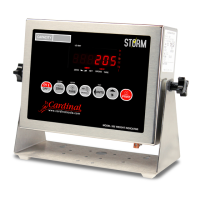8
INSTALLATION, Cont.
MODEL 205/210
1. Loosen the cable gland connector(s) for the serial cable. The gland connector(s) for the
serial data are located on the rear panel of the enclosure. Refer to Figure No. 4 for an
illustration of the gland connector layout.
2. Slip the serial cable throught the gland connector and into the enclosure.
3. Remove 2" of the outer insulation jacket then remove 1/4" of insulation from each of the
wires (refer to Figure No. 5).
4. Connect each of the wires to the Serial Data terminal block (P2) referring to Figure No. 6 for
terminal block locations.
5. To terminate, first press down on the release bar for the terminal, insert the wire into the
opening then allow the release bar to return to its original position, locking the wire in place.
Repeat the procedure until all of the wires are in place.
BI-DIRECTIONAL SERIAL INTERFACE SERIAL OUTPUT
PIN NO. Function PIN NO. Function
1 TXD 1 - RS232 5 TXD 2 - RS232
2 RXD 1 - RS232 6 TXD 2 – 20 mA Active
3 TXD 1 – 20 mA Active 7 GROUND
4 GROUND
OPTICALLY ISOLATED INPUTS
Included with the I/O are 4 programmable inputs that may be used to remotely (up to 100 feet)
initiate various functions within the indicator. These inputs are accessed via a terminal block on
the back of the PC board (see Figure No. 6). The 4 inputs are defined as follows:
•
one is for Zero,
•
another is for Tare,
• the third is for Print,
• and the fourth is for Gross.
Figure No. 6 illustrates the layout of this connector and identifies the inputs for Zero, Tare, Print
and Gross. Remember that the input must be connected to Gnd to initiate the function.
PIN NO.
Function
1 Gross
2 Print
3 Zero
4 Tare
5 Common
PRESET WEIGHT COMPARATOR/CHECKWEIGHER LOGIC LEVEL OUTPUT
(Optional, Model 210 Only)
If you so choose, you may use the logic level outputs from your Model 210 indicator’s preset
weight comparators or checkweigher to control peripheral devices used to manage the flow of
material or signal when the weight is within preset limits. Note that these outputs are at logic level
and cannot drive external devices directly. Solid state relays can be used to accept the logic level
output from the 210 and in turn, drive the external device.
To connect the control cable to the preset weight comparator/checkweigher logic level output
connector P10, first loosen the gland connector located on the back of the 210 on the right side.
Refer to Figure No. 4 for the exact location of this connector. Slip the cable through this connector
and into the enclosure. Remove 2 inches of the cable insulating jacket then 1/4 inch of insulation
from each of the internal wires (refer to Figure No. 5). Make the proper terminations on terminal
block P10. To terminate a wire, first press down on the terminal block release bar, insert the wire
into the terminal and remove pressure from the release bar locking the wire in place.

